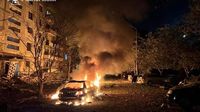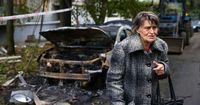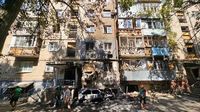In the early hours of October 5, 2025, Ukraine awoke to one of the most extensive and devastating aerial assaults it has experienced since the start of the Russian invasion. According to President Volodymyr Zelenskyy, the overnight barrage involved more than 50 missiles and approximately 500 drones, targeting civilian infrastructure across at least nine regions. The attack left a trail of destruction, death, and disruption from Zaporizhzhia in the south to Lviv in the west, and sounded a grim warning that the war’s intensity is far from abating.
The scale and coordination of the strikes were immediately apparent. Ukrainian authorities reported that the Russian military deployed a combination of ballistic missiles, cruise missiles, and guided aerial bombs, as well as swarms of Shahed attack drones. The operation, as reported by BBC and Ukrainian officials, was designed to overwhelm air defenses and inflict maximum damage on energy facilities, transportation networks, and residential neighborhoods.
Zaporizhzhia was among the first cities hit. Drones and KAB-guided bombs struck the city, resulting in the death of one person and injuries to nine others, including a 16-year-old girl. The attack caused widespread power and water outages, leaving some 73,000 households in darkness and damaging several residential buildings. In the words of President Zelenskyy, “We need more protection and faster implementation of all defense agreements, especially in the field of air defense, to take the sense out of this air terror.”
As the night wore on, the assault shifted westward. Lviv, long considered a relative safe haven due to its proximity to the Polish border, endured its heaviest bombardment in months. According to the head of the Lviv Regional Administration, Maksym Kozytsky, a residential building in Lapaivka was directly hit, killing a family of four—including a young girl—and injuring six others. In total, more than 45 explosions were recorded in Lviv, with two Kinzhal hypersonic missiles striking the city. The attacks set off a major fire at the Sparrow industrial park, destroyed one home, damaged eight others, and forced public transport to a halt. Mayor Andrij Sadowyj emphasized that there were no military targets at the industrial site, underscoring the civilian nature of the devastation.
Other regions were not spared. In the Cherkasy district, a drone strike damaged a power line, causing further electricity outages. In the Sumy region, a Russian drone targeted a railway station in Shostka, killing one person and injuring around 30 more. The attack damaged both a local commuter train and a train bound for Kyiv, exacerbating transportation delays that rippled across the country. Meanwhile, a massive drone attack on a pig farm in Novovodolazka resulted in the deaths of approximately 13,000 pigs in a fire, with only 2,000 surviving—a stark reminder of the collateral damage inflicted on Ukraine’s agriculture sector.
Kherson, a city liberated by Ukrainian forces in November 2022, continued to bear the brunt of relentless Russian artillery and drone strikes. On the morning of October 5, a 77-year-old man was killed while outdoors as Russian forces shelled the city once again. The Kherson Regional Prosecutor’s Office has opened a pre-trial investigation, classifying the strike as a war crime. Since its liberation, Kherson has endured over 39,000 attacks in 2024 alone, leaving 251 people dead and 1,838 injured. The city’s remaining 60,000 residents live under constant threat, with researchers describing Russian tactics as a “human safari”—using drones to hunt individual civilians and even targeting rescue workers responding to initial strikes.
The repeated targeting of energy infrastructure was a central feature of the assault. According to the Ukrainian Ministry of Energy, major power outages were reported in Zaporizhzhia and other affected regions. In some areas, the supply had to be shut down entirely to allow for emergency repairs. The Russian Ministry of Defense confirmed its forces targeted Ukraine’s energy infrastructure and military positions, including a HIMARS artillery system in the Kharkiv region, claiming all intended targets were destroyed. Ukrainian authorities, however, have not confirmed these claims, and independent verification remains elusive.
The humanitarian toll of the attacks is staggering. At least five civilians were confirmed dead in the initial aftermath, with authorities warning that the number could rise as rescue and recovery efforts continued. Among the dead in Lviv were all members of a single family, a tragedy that Foreign Minister Andrij Sybiha described as emblematic of Russia’s ongoing “terror.” Sybiha called for “stronger transatlantic pressure on Russia” and argued that “anyone buying energy from Russia was helping to finance the crimes against Ukraine.”
Emergency crews worked through the night and into the morning, battling fires, clearing debris, and restoring electricity where possible. Yet, the scale of the damage meant that many regions faced prolonged outages and disrupted transport. The Ukrainian government urged citizens to conserve energy and remain vigilant, warning that Russia may attempt to sustain this level of bombardment over multiple days. Air raid sirens echoed repeatedly through major cities such as Kyiv, Kharkiv, and Dnipro, as waves of drones and missiles kept residents on edge.
International observers and neighboring countries closely monitored the situation. Poland, which shares a border with Ukraine’s Lviv region, temporarily deployed fighter jets and ground-based air defense systems as a precaution. The Polish military confirmed that no violation of its airspace occurred during the attacks. Dutch F-35 fighter jets also assisted in the protection of Polish airspace, a routine operation during periods of heightened tension in western Ukraine.
Russia’s strategy of mass drone and missile strikes appears aimed at weakening Ukraine’s logistical and energy capacity ahead of the winter season. This tactic, reminiscent of previous winters, threatens to plunge millions into cold and darkness as temperatures drop. Ukrainian officials have accused Moscow of deliberately targeting heating and power systems to inflict maximum suffering on the civilian population. The attacks also come in the wake of Ukrainian drone strikes on Russian oil refineries and fuel depots, which have led to fuel shortages and prompted Russia to extend its export ban on petrol and diesel until the end of the year.
As Ukraine continues to assess the full extent of the damage, the country’s leadership remains resolute. President Zelenskyy has called for a “ceasefire in the sky,” suggesting that enhanced air defense and international support could pave the way for real diplomacy. For now, however, the overnight assault stands as a stark reminder of the war’s persistent volatility and the immense challenges facing Ukraine’s defenses—and its people—as winter approaches.


